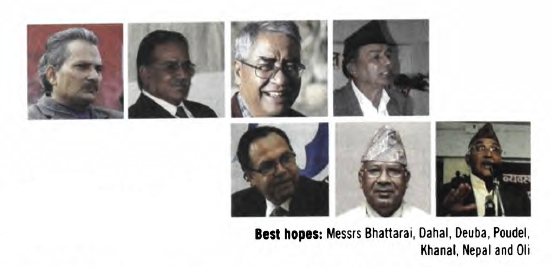From Himal Southasian, Volume 23, Number 8 (AUG 2010)
Either Nepali politics is incredibly unscrupulous or it is a trailblazer, with some of the more sensitively democratic politicians chaperoning a post-conflict society. Take the case of the elections for the prime minister, which is hanging fire as Himal Southasian goes to press.
First, the background. Prime Minister Pushpa Kamal Dahal (‘Prachanda’) resigned on 4 May 2009, when President Ram Baran Yadav overruled his order firing the chief of the army staff of the Nepal Army, citing constitutional irregularity. Now, Madhav Kumar Nepal had lost in two constituencies to the Maoists in the elections of April 2008, but it was the Maoists who suggested to the Communist Party of Nepal (Unified Marxist-Leninist) – Madhav Nepal’s party – that he be nominated to the Constituent Assembly because his skills in consensual politics would help in the writing of the constitution.
Lo, as soon as the Maoists exited government, Madhav Nepal was propelled to lead the 22-party coalition. Thereupon, he became (together with President Yadav) the archenemy of the Maoists – as a transforming party that still needs ‘enemies’, in accordance with its lingering rebel-type working methods. The accusation that a two-constituency failure was made prime minister fell flat when it came from the Maoists.
Soon enough, the Unified Communist Party of Nepal (Maoist) realised that it had given up the government in haste. After all, it had all the important ministries, including Finance, Defence, Peace and Reconstruction, Law and Justice, General Administration, Labour and Transport, Local Government, Information, Tourism – and even Home, in the custody of a Maoist faithful. But then, all the birds in hand had been let go in a show of fatal bravado. When the Maoist leaders realised that they could not break the 22-party alliance and make up a 301-member majority in the 601-seat Constituent Assembly – which would have required them to wean away just 72 members – they opted for bull-headed action. They maintained that their 229 members in the House, or 38 percent, represented a ‘mandate to rule’; but when no one else was convinced, they decided to get back into government by using ‘state capture from the street’.
In retrospect, the greatest contribution of Prime Minister Nepal’s cabinet – extremely weak, because it was saddled with pedestrian members – was holding on to government for 13 months, four more than what the Maoists had been able to accomplish. During this period, the Maoists tried talking tough, ultra-nationalism, country-wide closures and other forms of brinkmanship, before finally realising there was no recourse but a return to the Constituent Assembly and parliamentary process. On 30 June, Madhav Kumar Nepal resigned – incidentally, not because the Maoists had made governing impossible, but because he perceived humiliation at the looming parliamentary budget session from within his own party.
Now, it came time for the three largest parties to propose candidates for the prime-ministerial seat. But even as Prime Minister Nepal became a caretaker, deep divisions in each party emerged from the foggy political landscape. In the UCPN (Maoist), Dahal could not afford to be sidelined, so he did everything to marginalise his challenger, Baburam Bhattarai, including accusing him of being an Indian lackey. The CPN (UML)’s Chairman Jhala Nath Khanal has long felt that the prime-ministerial office should have been his, but a powerful flank led by Madhav Nepal and party boss K P Oli felt that it should be the turn of the third large party, the Nepali Congress, to lead. In the Congress, the four-time Prime Minister Sher Bahadur Deuba said he was the natural choice, but his party mates thought otherwise, deciding instead to go with the elected leader of the parliamentary party, Ram Chandra Poudel.
So there the public was faced with the unique situation in which each prime-ministerial candidate had been proposed by his archrival – knowing full well that the situation had not ripened enough for any party to get the numbers to form a majority government, much less support of all parties to form a ‘national unity’ government. So, each looking very earnest, Bhattarai proposed Dahal for prime minister, Deuba proposed Poudel, and Nepal proposed Khanal. Of course this did not work in terms of anyone managing a majority, and thus there is still some time, perspiration and heartburn in the road ahead before Nepal gets a new prime minister.
Even in normal times in ‘normal’ countries, horse-trading between political parties is expected when no party commands a majority. But Nepal remains in the middle of an incomplete peace process, with the Maoist fighting force still in place in UN-supervised cantonments. This is also a country that is trying (unsuccessfully, as yet) to write a constitution, even as the writ of government has weakened, impunity is rife, and angry communities are making demands from the enfeebled state. Populism rules the roost, and the political parties are intimidated from taking strong positions when, amidst rampant anti-intellectualism, the civil society refrains from ‘saying it like it is’ on existential issues such as the demobilisation of Maoist cadres, the definition of federalism and the foundational principles of the forthcoming constitution.
The chatter in the Kathmandu media is all about how self-centred the politicians are, how they fiddle as the country collapses. But this is an ahistorical, non-contextual position, which refuses to take into account the challenges that confront politicians in a polity that is attempting to write a constitution while convincing the largest party to forgo violence as a political tool. Against such challenges, the politicians of Nepal look rather fast-footed and principled. Their job is to ensure that Nepal lands on all four feet as a country in peace and democracy, guaranteed by the new democratic constitution.